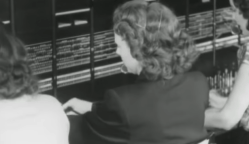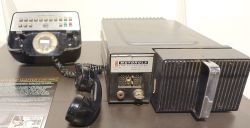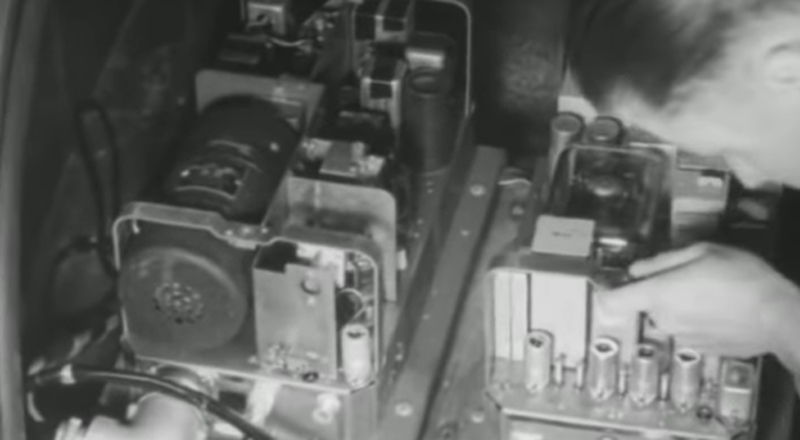We think of the mobile phone — well, what we would call a cell phone — as something fairly modern. Many of us can still remember when using a ham radio phone patch from your parked car would have people staring and murmuring. But it turns out in the late 1940s, Bell Telephone offered Mobile Telephone Service (MTS). It was expensive and didn’t work as well as what we have now, but it did let you make or receive calls from your automobile. After the break, you can see a promotional film about MTS.
The service rolled out in St. Louis in the middle of 1946. The 80-pound radios went in the trunk with a remote handset wired to the dashboard. At first, there were only 3 channels but later Bell added 29 more to keep up with demand. An operator connected incoming and outbound calls and if three other people were using their mobile phones, you were out of luck.
Use Cases and Gear
The video shows a truck driving team that receives a call to make an unscheduled pickup, then a worker who calls the main office while out in the field. There were a lot of manual steps to determine what base station to use for the call. It isn’t obvious until close to the end of the video, but the system was half-duplex. You had to push a button on the handset to talk.
The radio gear shows up around seven minutes. Be prepared. They are going to tell you the two units are “compact!” The dynamotor that supplies plate voltage to the transmitting tubes alone probably weighs 15 times your largest cell phone’s weight. Not to mention there was a possibility your vehicle would need to have a larger battery and alternator installed. As big as these were, the output power was only about 3 watts.
If you want more technical detail and some great pictures, [wb6nvh] has a really good page detailing the history of MTS.
Base Station
Around the eight minute mark, you can see the base station antennas and radios. In the middle was an operator sitting at a classic switchboard. There were two services available: an urban service that had radios in cities and the highway service had antennas along major roadways.
 The frequency, by the way, was in several bands. The low VHF band was around 40 MHz for the highway service and around 150 MHz — not far from the current 2-meter ham band — for the urban service. At first, you had to listen for the operator to announce your mobile phone number, but this was soon replaced by selective calling as seen in the video.
The frequency, by the way, was in several bands. The low VHF band was around 40 MHz for the highway service and around 150 MHz — not far from the current 2-meter ham band — for the urban service. At first, you had to listen for the operator to announce your mobile phone number, but this was soon replaced by selective calling as seen in the video.
There was a variant of MTS that used shortwave frequencies and single sideband. Of course, that was noisy and finicky. There was also some use of MTS to make public phone calls on a train.
Before Cell
Common sense would make you think that a “good” radio system would have high power and a large footprint. The problem with that is that the larger area invalidates a channel for all users in that area.
The key to successful mobile service was to make transmitters weak and antennas very directional and low range. This allows you to restrict a set of channels to a small region or cell. Those same frequencies can then find use again in a nearby, but not adjacent, cell.
This made it hard to fit too many customers into the mobile system. In some cities, the waiting list was about three years. Prices were high because the systems were often at full capacity so encouraging new subscribers didn’t make sense.
Farewell MTS
 MTS hung around until the 1980s. But by 1964, the writing was on the wall and Improved Mobile Telephone Service (IMTS) was available. IMTS has direct dialing and full-duplex. A common IMTS phone, the 25 watt Motorola TLD-1100, had two roughly 8-inch square circuit boards to locate an idle channel and do other channel management via audio tones. That is, an idle channel had a 2 kHz tone transmitted, while a busy channel had 1.8 kHz. You could even get an IMTS phone in a briefcase.
MTS hung around until the 1980s. But by 1964, the writing was on the wall and Improved Mobile Telephone Service (IMTS) was available. IMTS has direct dialing and full-duplex. A common IMTS phone, the 25 watt Motorola TLD-1100, had two roughly 8-inch square circuit boards to locate an idle channel and do other channel management via audio tones. That is, an idle channel had a 2 kHz tone transmitted, while a busy channel had 1.8 kHz. You could even get an IMTS phone in a briefcase.
Phones have a very rich history. We’ve even looked at a Rube Goldberg-style answering machine.















Microwave ovens, fax machine, color tv all much older than you think.
Yea, lots of times the idea comes before the technology to implement it truly well. That’s why we don’t have flying cars and sexbots that can cook and do laundry yet.
Doesn’t the fax machine pre-date the transatlantic cable?
I watch Murdoch Mysteries and they had an episode where he invents it right before the turn if the century. I recently realized that the old wanted posters could have been faxed but haven’t made time to research that.
It does. The pantelegraph was used to transmit small pictures and handwritten text over telegraph wires.
Napoleon used a mimeograph over telegraph lines for pictures, so I would say yes, by about 100 years lol. I think I read there were Atlantic cables by mid 19th century.
True as far as that statement goes, but a whole lot of time, sometimes decades before they became wide spread consumer items. Hell broadcast radio really couldn’t shine, until the superhet receivers replaced TRF receivers.
I’m not sure of that assessment.
The superhet was patented in 1920. Armstrong sold the patent to RCA, which wouldn’t license the patent to other companies until 1930.
For a “long time” radio had limited use. Ship to shore was about the biggest thing, licensing came in because of that. And WWI got in the way, and right after the US navy wanted radio only for itself.
Broadcasting was informal, I gather some caught on that there were more people with receivers than transmitters, and started aiming towards them. That would be hams broadvasting. KDKA went on air in 1922, and is credited as the first broadcast station.
Broadcasting was odd at the start, often a station on air for a few hours a day and often linked to an existing business. It took some time before advertising was sold.
It also took time for the spectrum to be widened. Noisy spark gaps took.up room, I can’t remember when they started fading, or were banned. And everything was below about the too of the current AM Broadcast band, with ships I think getting priority. Hams were relegated to the “useless” frequencies above about 1600KHz, but in December 1921 they had transatlantic tests, which showed that shortwave was useful fkr distant use, which opened up frequencies.
So I think other factors limited broadvast rather than receiver type. It takes time fir new technology to find use, and for people to come to it.
Fax machine 1865! Look it up.
A pantelegraph or mimeograph by telegraph line predates the fax by about 70 to 80 years
TILT
My first boss owned several businesses, and had an IMTS radio in his car. He had a traditional princess phone mounted on the transmission hump. I worked in a grinding shop in the city, and he had a second machine shop about 50 minutes away, out past “the lake”. Even though it was quite expensive per minute, he used it a lot on his long daily commutes.
I’m not convinced that his business at the time was so amazing that it required him to have a mobile phone, but it was pretty cool that he had it. As I recall from using it once or twice that the sound quality wasn’t great, but it was good enough to understand the other side.
My dad had four IMTS units in his oil well servicing business. When he purchased a momble radio system, he reduced the number of mobile phones to three. The audio of the mobile phones was similar to the audio of the mobile radios. Both had the line of sight issue, that are still in place today
Maybe it wasn’t his business but his side business that paid for it.
All two-way radios were in the trunk, even into the solid state age. I’m not sure when it changed.
One reason 2M FM took off was because commercial 2-way was ordeed to go narrower, and it was cheaper to buy new than modify the old (probably helped that new equioment was also an excuse to go solid state). So many hams had big heavy equioment in the trunk with a control unit under the dash board, all surplus from commercial 2-way. Or people like me, a mobile unit with an AC power supply. Actually, the transceivers were often a transmitter, receiver and power supply in separate strips, so the radios were base or mobioe depending on power supply, and casing.
And those heavy transceivers reigned on 2M for just a few years, soon there were solid state units aimed at the ham market, expensive but so.much lighter and way less current drain. And a few years after that they were synthesized, all the frequencies without having to buy two crystals for each.
My first 2m rig was a GE Preprogress bought from a ham fest. When you keyed the remote you could hear the whine of the dynamotor and the plates on the finals would glow blue.
Then I got a Cleg FM-27B which was a marvel and didn’t take crystals… but not really the way you think, either. It was a strange arrangement.
I had a Cleg FM27B as well… very interesting radio it was..
I had an RCA Carfone in 1972, free from someone who had a stash of them, he worked for RCA. It was a mobile, I just scrounged some hefty transformers to supply 12V and fed them where the vibrators otherwise converted DC to AC for the set’s transformers.
The Clegg was interesting since there were three iterations. The first had a sybtyesizer for receive, but needed individual crystals for each transmit channel. The 27A added a synthesizer for transmit, but a limited span. The 27B widened the coverage.
And of course, the synthesizer worked by mixing crystal oscillators to get the needed frequency. So there were a bunch of crystals, but not as many as one or two per channel. Like early synthesized CB sets.
That too was a brief time, soon PLL synthesizers took over. The GLB with RTL maybe preceeded the 27.
Yah it didn’t take channel-specific crystals. At W5YD (Miss. State Club station) we had an Icom 22S which had the diode programmable synthesizer. We wired a switch box to it so that one of the channels could go anywhere we wanted it to and used it as a CW transmitter to work OSCAR.
The RS/Tandy/Archer walkie talkie set I’ve got must have been from the time when crystals were cheaper than PLLs, they’re 3 channel switchable, but each channel needs it’s own crystal.
Early 60’s my older sisters date had a car telephone, the handset was on the hump. In Indianapolis, he was in real-estate.
In that banner photo one can make out the dyno on the left, spinning out HV B+ for all those tubes.
In 1970 i modified a valve transceiver to 53MHz (53.866 IIRC). Built a solid state inverter for the 400V plate voltage. Ran it in my 6V VW. Took over 30A on transmit. My tx time was limited to about 90 seconds an over as it would blow the fuse and crash my battery. Had a larger 6V truck battery on the floor as a backup.
My father installed radios and these after he got out of the Navy as a tech. Yes. they went into the trunk. Not small.
Very interesting post with equally interesting and enlightening responses!